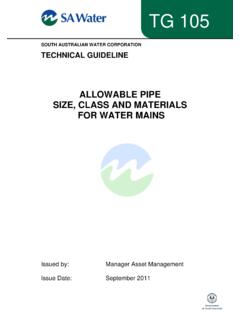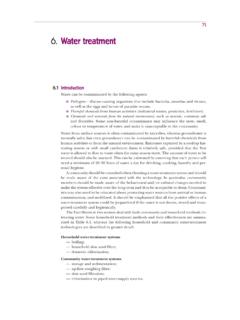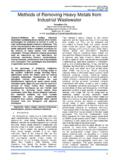Transcription of Dissolved Air Floatation (DAF) - SAWater
1 Dissolved Air Flotation (DAF). Trade Waste Guideline Reviewed 1/03/2013. INTRODUCTION. Grease arrestors are the simplest devices for the removal of grease and oil (G&O), and fine suspended solids (SS) from trade wastewater. Their simple operating principle using adequate retention time and differences in specific gravity to separate and retain contaminants, produces wastewater quality under ideal conditions that is acceptable for small trade waste discharges. However, their effectiveness drops greatly in many everyday circumstances despite regular maintenance pump-outs. For example;. Sustained periods of high inflow rate reduce the retention time and the arrestor's ability to separate contaminants or reduce temperature. Short periods of excessive flow can flush some of the retained contaminants from the arrestor to sewer. Poor aeration of wastewater promotes anaerobic decay of retained contaminants, leading to foul odours and acidic (low pH) discharge to sewer.
2 Arrestors cannot retain significant amounts of SS or G&O before some of this carries over to sewer. G&O that is emulsified by strong detergents or alkaline/caustic cleaning agents cannot be separated. Trade waste activities where grease arrestors have proven to be an inadequate pre-treatment option include: Industrial activities such Discharges with high Food courts and other as food manufacturing G&O or SS large food service concentrations activities Activities with periodic caustic discharges or other factors that inhibit simple gravity separation Pre-treatment of trade wastewater by a system based on the Dissolved Air Flotation (DAF) principle is a commonly used best practice option, where grease arrestors or other simple passive pre- treatment devices are inadequate. At its heart, micro fine bubbles of air generated in the DAF vessel combine with insoluble contaminants in the wastewater, lifting them to the surface.
3 Mechanical scrapers remove the floating sludge layer and the purified wastewater discharges to sewer. This achieves superior results at higher flow and contaminant loadings than can be achieved by conventional gravity separation technologies. The DAF unit is only one element of a multi-component wastewater treatment system that controls and pre-conditions wastewater for optimum DAF operation. Selection and sizing of individual components from the range of possible alternatives requires technical expertise from a supplier or consultant to arrive at a DAF treatment package that delivers a reliable, cost-effective solution to each customer's specific wastewater treatment needs. This guideline is not professional technical advice. Our intent is to provide trade waste generators with some insights into the specific areas of system design and set down a number of aspects that we have found to be essential for effective operation.
4 WHEN DO I NEED A DAF SYSTEM? Retail activity For a new site with multiple trade waste activities ( shopping centre, food court, large food service area) where the combined calculated grease arrestor capacity requirement for all activities exceeds 12000 litres (using the indicative sizing methods and rules given in the Trade Waste Commercial Food Preparation and Service Guideline). o For development projects use 2400 litres for each unleased retail food tenancy with a trade waste connection, when calculating pre-treatment capacity. o Do not include tenancies where trade waste discharge risers are provided for future contingency, but are currently sealed below finished floor level. However, appropriate design consideration should be given for future hook-up/development. For an existing site with multiple trade waste activities if the scale, scope or number of activities has changed from the original, or it becomes evident that changes will occur, to the extent that the new combined calculated capacity exceeds 12,000L, and it is reasonably viable to group sufficient individual discharges to make DAF or similar pre-treatment practical.
5 For an existing site with multiple trade waste activities if sewer chokes or other negative impacts on the downstream sewer are attributed to a site's discharge and compliance with acceptable discharge quality cannot be achieved by optimising the existing pre-treatment devices and DAF or similar pre-treatment is a practical solution. Industrial activity DAF units are widely used for treating industrial trade wastes high in solids, grease and insoluble BOD. Most industrial processes (including food manufacturing) cannot maintain adequate trade waste discharge quality through a conventional grease arrestor or settling pit. This can be simply explained by the higher loads, higher flows and higher temperatures that result in poor separation in the arrestor/pit. For existing sites where chokes or other negative impacts on the downstream sewer are caused by a site's discharge, and DAF or similar pre-treatment is a practical solution.
6 For existing sites where SA Water has determined that discharge quality significantly exceeds one or more acceptance limits, and DAF or similar pre-treatment is a practical solution. For proposed new trade waste discharges, if DAF is proven in comparable situations to be a suitable, best practice trade waste treatment option. A TYPICAL DAF SYSTEM. Influent raw trade waste 1. Screen 2. Buffer/Holding Tank 3. Pre-treatment 4. pH correction / chemical addition (if required). 5. Pre-reaction tank (if required). 6. DAF unit 7. Sludge / screenings disposal 8. Monitoring /metering Discharge to sewer 1. Screening Adequate screening to remove gross solids from trade waste influent, buffering and treatment steps is crucial as it: Prevents solids blocking/damaging wastewater feed pumps, DAF recycle pumps and sludge pumps. Limits odours produced by anaerobic degradation of settled sludge that build up in the DAF.
7 Unit and buffer tank. Reducing the build-up minimises the need for complete vessel clean out. Minimises sludge formation over the aeration bars in the DAF unit, which could otherwise upset micro-bubble formation. Reduces coagulant/flocculant consumption (if used at a later stage) by first removing as many solids as possible by simpler means. A variety of screening mechanisms is available. Careful matching of the design and hole/mesh size with typical particle size and other wastewater characteristics is necessary. Rotating drum/sieve and bow shaped wedge-wire screens are commonly used. In retail food preparation/service areas, silt trap baskets are useful for preventing localised drain blockages, but are not an acceptable mechanism for screening before a DAF. A centralised screening mechanism with maximum 1mm hole/mesh size for processing all wastewater destined for DAF. treatment is necessary.
8 2. Buffering / holding tank Ensuring the influent is as consistent as possible over a production period or daily DAF operating cycle is crucial for optimum DAF performance. Collecting screened wastewater in a buffering/holding tank for a sufficiently long period before further treatment moderates short-term variations in quality. The key parameters to be moderated are;. Temperature Elevated temperature or hot slugs' of material can emulsify G&O resulting in a higher percentage of carryover through the DAF unit, hinder the supply of Dissolved air and promote undesirable biological breakdown of material in the DAF unit. Temperature in the DAF vessel should be maintained below 40 degrees C. pH. pH inconsistencies can result in potential damage to treatment equipment, odours and non- compliance with the trade waste discharge limit of pH 6-10 at all times. Buffering of pH by mixing acidic and alkaline discharges might eliminate the need for chemical pH correction, or reduce alkali/acid dosing costs and their undesirable Total Dissolved Solids (TDS) impact.
9 Solids The recycle volume and air settings are set manually, to arrive at the desired air to solids ratio in the DAF vessel. Similarly, the dose rate of flocculant (floc) or coagulant (coag) is set to efficiently treat a certain concentration of contaminants. The DAF unit cannot automatically vary the settings to accommodate wide fluctuations in wastewater quality. Solids carryover to sewer is likely if higher than expected concentrations of solids enter the unit. Buffering moderates variations in wastewater solids concentrations and is a better alternative to adjusting the ongoing DAF settings, for effectively coping with short-term high contaminant concentration events. Careful investigation of wastewater quality and flow variations is needed to arrive at an effective buffering/holding tank capacity. The minimum capacity varies significantly between individual applications, particularly industrial sites.
10 However, a typical minimum buffering tank capacity of 4. hours at design peak influent flow rate is required for centralised retail applications. Other Buffering Considerations Appropriate mixing of tank contents ensures that solids and fats do not separate out, and tank contents remain aerated to minimise odours from biodegradation of waste before treatment. Extra contingency capacity in buffer tank storage is advisable for emergencies ( DAF unit maintenance shutdown, sewer unavailability). It also allows for increasing the normal operating levels, if required to achieve the desired buffering of wastewater. However, holding wastewater for excessive periods due to overly generous buffering capacity or delays in processing wastewater can lead to degradation of influent, odours and lower wastewater pH. During low flow periods, the buffering volume should be adjusted accordingly. During prolonged shutdown periods, it is advisable to process the buffer tank contents through the DAF unit and have the sludge from the buffer tank and DAF cell hauled off site.



